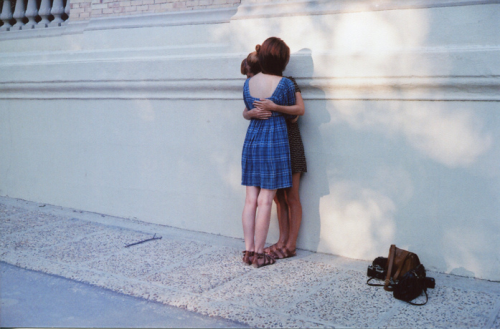There's a quiet, domestic street in Homerton that hides, as is so often the case in London, a fantastic little gem. You need to know to look for the Double Negative Darkroom or it would easily pass you by, but once you know it's there you'll be sure to seek it out again.
The Darkroom is a budding independent photographic lab, housing a community of photographers and artists who all come to talk shop with one another and share ideas. Specializing in alternative photographic processes and silver gelatin printing, the space consists of a myriad of processing rooms as well as a gallery, and monthly workshops on everything from 3 Colour Gum Printing to Wet Collodion Processing.
We spoke to Sebastian Sussmann, the founder of the Darkroom, and Tina Rowe, a resident artist, about how the darkroom began and what it's like to work at something with often unpredictable results.

Seb. Five years ago I started a darkroom in Hackney Wick, and a year and a half later I discovered this space in Clapton. There are darkrooms in derelict buildings all over London and I was in a habit of walking around trying to find them. The printmaker who shared this space invited me to use it, and so I moved the darkroom here.
I’d always had a very keen interest in photography. Before I did what I do now I had a bunch of office jobs, and then I moved to Sweden for a couple of years and that was where I really got into darkrooms; I ended up spending about 40 hours a week in them. I was inspired by a friend of mine who had his own darkroom, and I wanted to begin something for myself that had a strong lab element. I started the darkroom when I moved back to the UK in between a couple of crappy jobs, and it just evolved.
The idea is to keep the place as artist-orientated as possible, to champion the artist, especially darkroom members, residents and friends; people who are producing work within a pretty vast scope of alternative or traditional analogue photography.

Tina. The reason I’m here is because I was moaning online about a photography course I was doing. Seb saw what I’d said, and invited me to come and do a lith printing course. I’d always hated darkrooms because they’re filled with beardy men who think there’s only one, very precise way of doing things, but lith printing is actually a way of printing that’s not quite so anal, and so it drew me back into it.
I’m happy here. I wasn’t particularly happy when I first came. I didn’t like my job, and everything was kind of trudging, but I’d always carried on taking photos and it’s all made sense in the end, my terrible film and camera habit. I’ve also met people that I can actually talk to about photography. My friends aren’t interested in it, but now I can have long and involved conversations with people at the studio about how long you can leave something in chemistry for, and I like those conversations.

Seb. There’s a real tradition within darkrooms of “this is how you do things”, and something we try to encourage people to do here is to experiment, and not be so rigid. We teach them the basics, and tell them that as long as you get those right then you’ll end up with something, but that you should play around with the parameters.
Failure’s something that I encourage students to embrace. It’s so important in the darkroom; being really comfortable with failure, and being comfortable with things not working, but knowing and learning from what happens. It’s so important for discovering things. Happy accidents, serendipity, whatever you want to call it; they’re huge factors in the darkroom, and you learn the best things by doing it completely wrong. It just clicks in your head a lot better, so I encourage people to fuck things up.



















 Harvard,
Harvard, 













